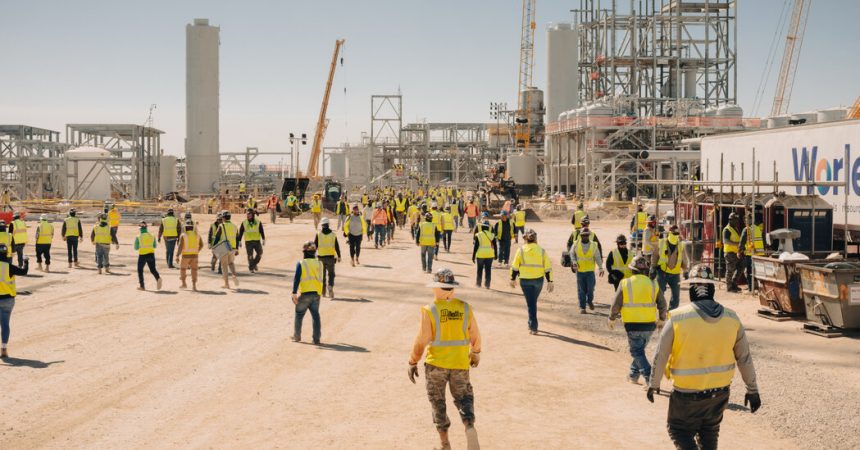(Editors note: This is the second edition of The Climate Fix, a twice-a-month look at some of the biggest and most promising solutions to climate change. Read the last version here. Got comments? Email us at Climateforward@nytimes.com.)
Thanks in large part to booming data center construction and the surge in artificial intelligence, electricity demand in the U.S. is rising for the first time in decades.
But the timing of this rise in demand, as far as the race to fight global warming goes, is awkward.
To help fight climate change, the nascent direct air capture industry is racing to develop technology to remove carbon dioxide directly from the sky. But in some areas of the country, the DAC industry is facing a shortage of available renewable energy to run its operations, particularly wind and solar power.
As David Gelles reported last year, there’s been a gold rush of investment over the last several years into companies that aim to pull carbon from the atmosphere, many of which then bury that carbon underground. One chief executive told Gelles that carbon dioxide removal was “the single greatest opportunity I’ve seen in 20 years of doing venture capital.”
Still, DAC companies, which are working to prove they can scale up their technology, have been vying for limited resources in an increasingly competitive U.S. power market.
CarbonCapture, a DAC company in California, is set to announce today that it plans to open a new plant in Louisiana, instead of Wyoming, partly because of “growing competition for clean power.”
The company said it plans to run its Louisiana facility, one of its first commercial plants, with clean power. “It’s still not easy,” said Adrian Corless, CarbonCapture’s chief executive. “There’s still a lot of competition for those projects.”
Louisiana is also home to Project Cypress, a regional DAC hub partly funded by the Energy Department. Climeworks, a Swiss company and a leader in the industry, is one of the DAC companies behind Project Cypress.
At an industry conference last year, Andrew Fishbein, the North America government affairs lead for Climeworks, said the company’s DAC facility would largely be run by solar power, but he also acknowledged the obstacles for the industry.
“The energy challenge is massive for us, and we can in no way minimize that,” he said.
DAC’s limitations
DAC can use a lot of energy, and much of that energy needs to be zero or low emissions to make sure that DAC plants capture more carbon than they release. Many of the industry’s techniques need between five and 10 gigajoules of energy to capture one ton of carbon dioxide, according to a 2024 report from the Bezos Earth Fund, which considers energy consumption one of the technology’s main obstacles.
Another barrier: The U.S. has a big backlog of requests from proposed power plants waiting to connect to the grid, 95 percent of which are for solar or wind energy, or battery storage, according to the Lawrence Berkeley National Laboratory.
DAC developers are even more limited by geography. Some parts of the U.S. have more suitable geologic formations for storing carbon underground than others — that’s part of the draw in Louisiana. The closer projects are to storage sites, the more money that can be saved on transportation.
The fight for renewable power
The renewable energy crunch, on top of the increased demand for electricity in the U.S., has pushed some to warm up to the idea of using fossil fuels to power DAC plants, CarbonCapture’s Corless said.
“There are definitely people who really want to completely separate the whole topic of direct air capture from the fossil fuel industry,” he said. “I’d say that voice is getting quieter than it was a couple years ago.”
For now, the slow rollout of renewable power, held back by permitting issues and the aging U.S. grid, has had a cascading effect.
“It’s not just DAC,” said Thomas Baker, a managing director at Boston Consulting Group focused on energy, climate and sustainability. Electric vehicle charging stations, data centers as well as states and corporations that have climate goals, are among those looking to secure more clean power, Baker said.
“Everyone is grappling a bit with, ‘How do we remove some of these soft barriers so we can continue to develop the renewables we need?’” he said.
More Climate Fix news:
Emissions: Only one of the 10 largest economies in the world submitted a plan to stay on track with the emissions cuts outlined in the Paris Agreement — the United Kingdom, Bloomberg writes. It plans to reduce carbon emissions 81 percent by 2035, relative to 1990 levels.
(Read about the several creative experiments across Britain that are trying to push the public to ditch fossil fuels.)
Renewable energy: Last year, the United States added 47 percent more clean energy capacity than in 2023, according to a new report by Cleanview, an energy data company.
Solar was a bright spot, with capacity rising nationally by 65 percent. And solar was a hit in Republican states: More than 25 percent of all solar deployed last year was built in Texas.
EVs: In January, global sales of electric and plug-in hybrid vehicles were up 18 percent over last year, Reuters reports. China’s BYD also added autonomous driving features to its less expensive EV models, including one that’s priced at $10,000.
A different kind of emissions: By belching and farting, cows emit methane, an extremely potent greenhouse gas. That adds up: Livestock are one of the biggest sources of human-related methane emissions. CNN reports that the Pirbright Institute in the U.K, a virology lab focusing on livestock, is leading a three-year study to develop a vaccine.
Sustainable dorms: The Times examines how New York University retrofitted a former hotel to build a more environmentally sustainable dormitory for students, while preserving the building’s landmark status and using passive house standards. The cost: $7 million.
Green flights of fancy: In 2015, Bertrand Piccard, a 66-year-old Swiss entrepreneur, flew a trip around the world in a solar-powered plane. Now, The Associated Press reports, he wants to fly a two-seater plane powered by green hydrogen around the world nonstop. The first test flights are expected next year.
An old idea: Heatmap News reports that Chestnut Carbon, a nature-based carbon removal company, raised $160 million in funding. The company focuses on planting trees in areas that haven’t traditionally had forests, a technique called afforestation.
Much of the funding will go toward buying land. “We look to build a forest that, if you had a time machine and you went back 100 years, would look very similar to what was there 100 years ago,” Greg Adams, the company’s chief financial officer, told Heatmap.







